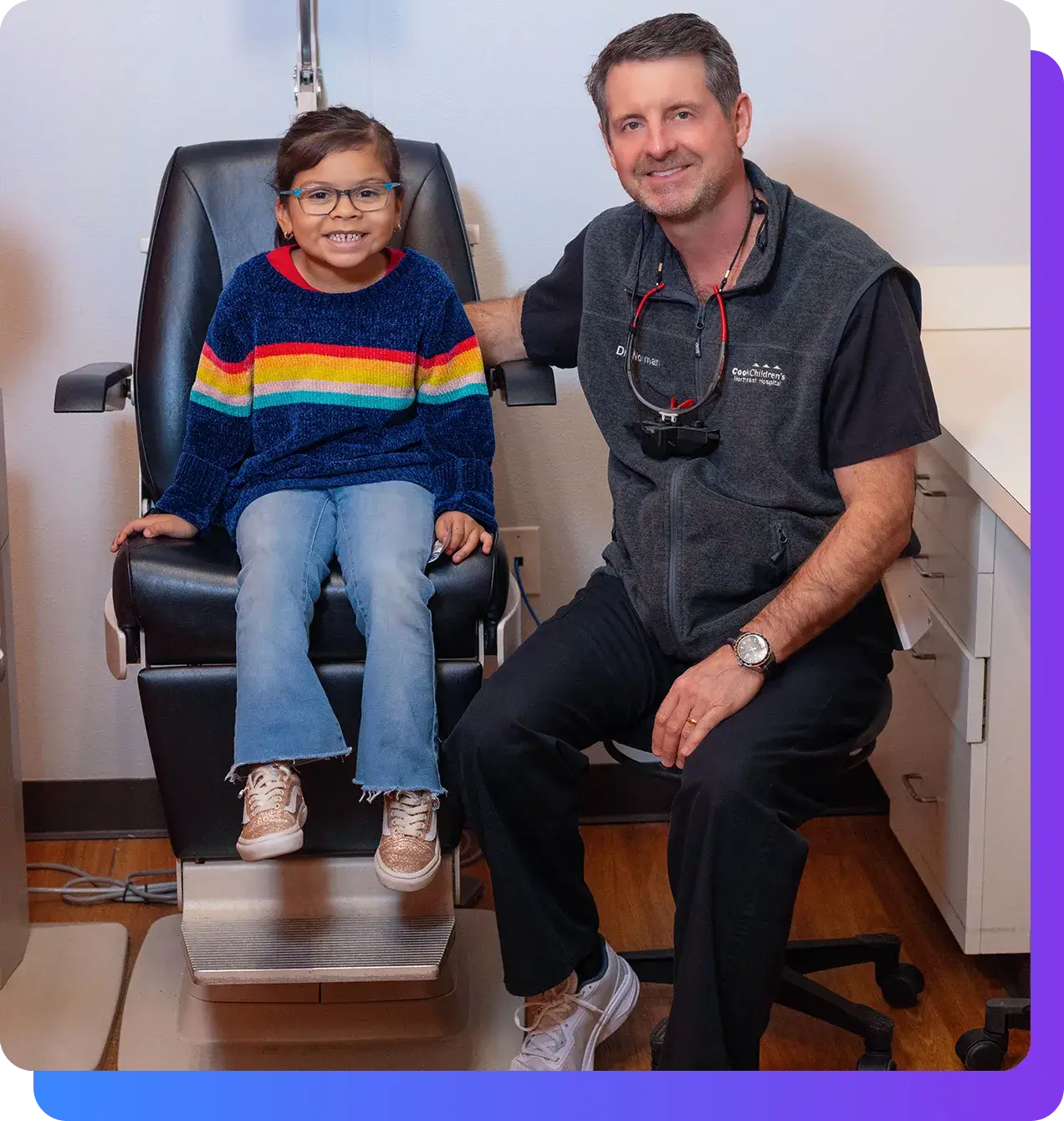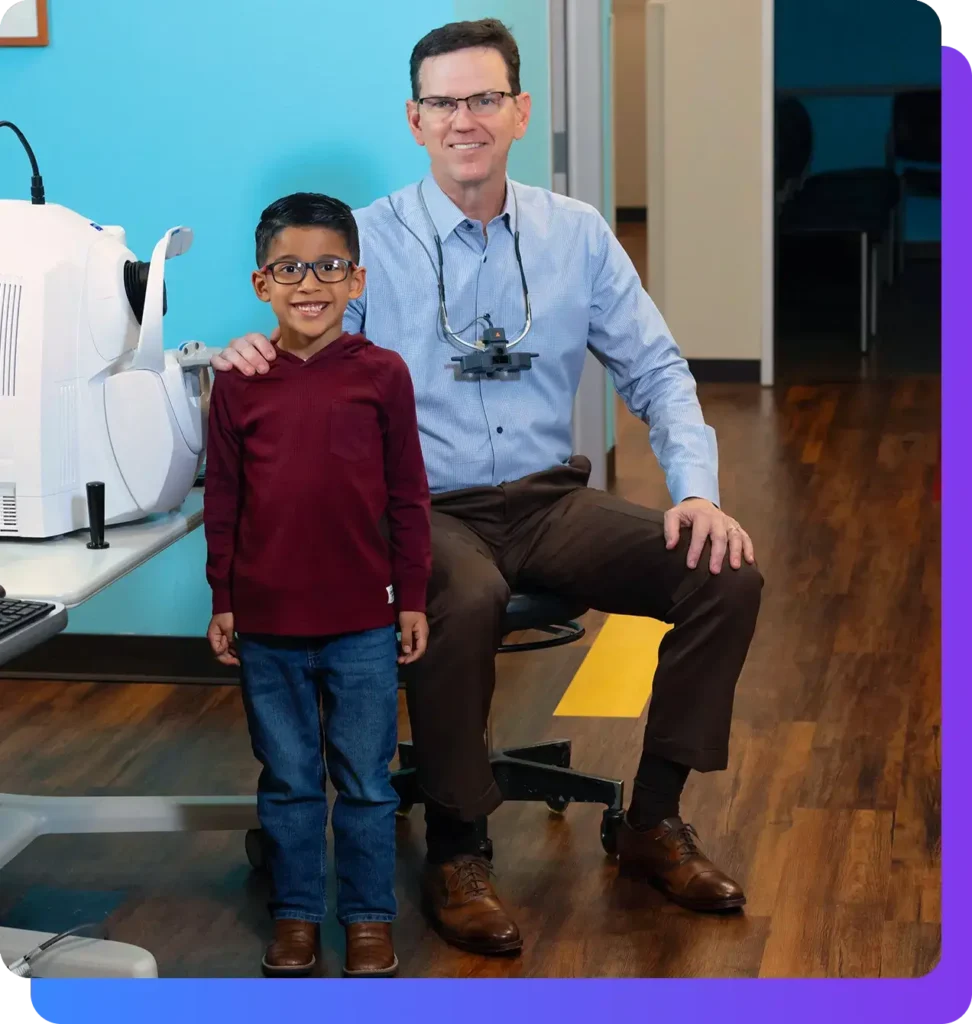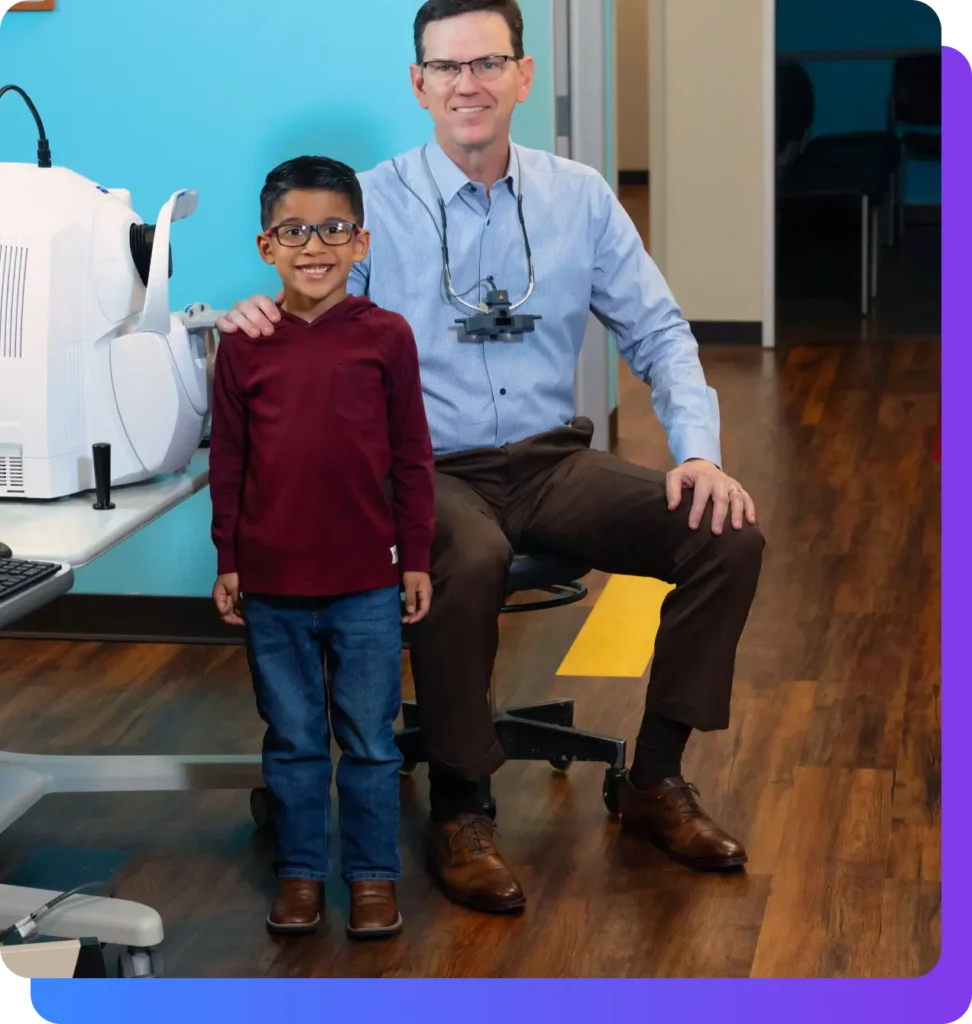Pediatric Conjunctivitis (Pink Eye)
Specialists in North Texas
Finding out that your child has Pediatric Conjunctivitis (Pink Eye) can be concerning as a parent. You may wonder how it will affect their comfort, vision, and ability to participate in daily activities, especially if they’re in school or around other children.
Expert Pediatric Conjunctivitis (Pink Eye) Treatment for North Texas
At Pediatric Eye Specialists, we understand the worries that come with a diagnosis of Pediatric Conjunctivitis (Pink Eye) and are here to provide the clarity and support you need. Our team is committed to delivering expert care and compassionate guidance to ensure your child’s comfort and recovery. Let’s explore how this condition can affect their vision, what it means for their overall eye health, and the best treatment options available. We are here to offer treatment, reassurance, and hope every step of the way.

The Basics: What is Pediatric Conjunctivitis (Pink Eye)?
At Pediatric Eye Specialists, we see many children with Pediatric Conjunctivitis (Pink Eye), a common condition that causes inflammation or infection of the conjunctiva—the thin membrane covering the white part of the eye and the inside of the eyelid. It can affect one or both eyes and has various causes. Viral conjunctivitis, often linked to adenovirus, is the most frequent type, while bacterial conjunctivitis can result from bacteria like Staphylococcus aureus or Haemophilus influenzae. Non-infectious conjunctivitis can be triggered by allergies, chemical irritants, or foreign objects in the eye. In newborns, it may develop due to blocked tear ducts or exposure to bacteria during birth. At Pediatric Eye Specialists, our experienced team provides expert evaluation and treatment to ensure your child’s comfort and recovery.
Why Choose the Pediatric Eye Specialists for Your Child's Pediatric Conjunctivitis (Pink Eye)
The Most Experienced Team in North Texas
With over sixty-five years of collective pediatric ophthalmology expertise, we offer your child unparalleled collaborative care.
Five Convenient Locations
Easily accessible care with offices in Fort Worth, Denton, Keller, Mansfield, and Prosper,
Unrushed, Clear Communication
We take the time to discuss your child's diagnosis and treatment, ensuring all your questions are answered to ease your concerns.
Affiliated with Cook Children’s Hospital
Our partnership with Cook Children’s Hospital means if your child needs surgery, imaging, or other specialists, they will be treated in one of the nation’s leading pediatric hospitals.
Specialized Expertise
Our expertise means that more optometrists, doctors, and specialists refer their pediatric eye patients to Pediatric Eye Specialists than any other pediatric eye practice in North Texas.
Child and Family Focused
Kids love us, and we love kids! We provide a caring environment for your child and your family.
Advanced Diagnostic Technology
We have the most comprehensive pediatric diagnostic suite in North Texas, allowing for precise diagnosis and highly personalized treatment plans.
Every Child Needs Access to Expert Eye Care
Championing the right to sight, we help navigate insurance, cash pay, and Medicaid options to make superior eye care feasible for all children regardless of their socioeconomic status.

The Benefits of Treating Pediatric Conjunctivitis (Pink Eye)
Treating Pediatric Conjunctivitis (Pink Eye) promptly can relieve discomfort and reduce the risk of spreading the infection. Early care helps manage symptoms, prevent complications, and support your child’s overall eye health.
Success You Can Expect for Your Child
Symptom Relief and Comfort
Treating Pediatric Conjunctivitis (Pink Eye) can help relieve discomfort and irritation. Artificial tears, warm or cool compresses, and in some cases, topical antibiotics can reduce symptoms, allowing your child to feel better sooner.
Prevention of Spread
Bacterial conjunctivitis is highly contagious, especially in school and daycare settings. Proper treatment, combined with good hygiene practices, can help reduce the risk of spreading the infection to other children and family members.
Faster Recovery for Bacterial Conjunctivitis
While most cases of bacterial conjunctivitis resolve on their own, antibiotic treatment can slightly shorten the duration of symptoms, helping your child return to normal activities sooner.
Supportive Care for Viral Conjunctivitis
Viral conjunctivitis does not respond to antibiotics, but supportive care, such as lubricating drops and compresses, can ease discomfort and help manage symptoms until the infection clears.
Effective Management of Allergic Conjunctivitis
For children with allergic conjunctivitis, antihistamine eye drops or oral antihistamines can significantly reduce itching, redness, and irritation, improving their overall comfort and eye health.
Special Considerations for Newborns and Contact Lens Wearers
In newborns, prompt treatment is essential to prevent potential complications that could affect eye health. For children who wear contact lenses, proper care and treatment can help prevent more serious conditions, such as corneal ulcers.
Real Stories,
Real Smiles.
“They were very good with my nonverbal toddler. It was the best doctor visit experience we have had yet. They were awesome, caring, and quick!.”

Amy Glover
Parent of Patient
“Today, Dr. Packwood saved my youngest from a life of blindness and worked a miracle for my family. I cannot express enough gratitude and thanks for their skillful surgery and expertise. 10 of 10 highly recommend.”

Atticus Lee
Parent of Patient
“The staff here is so amazing with my son. We had such a wonderful experience both at the office and for his surgery! I highly recommend Pediatric Eye Specialists!!!!“

Gianna Stutzman
Parent of Patient
“We are so grateful for the genuine care that Dr. Duff provided for our son Lorenzo, which prevented him from going blind! She is truly a gift to the community.“

JS Cocjin
Parent of Patient
“Professional, compassionate, kind and friendly. They took great care of my preemie baby from Day 1 of ROP. Very happy with how my daughter is progressing and has healthy eyes now.”

Suresh K.C.
Parent of Patient
“We’ve seen Dr. Hunt for the past 6 years since my daughter was 9 days old. We have multiple appointments each year and even eye surgery when she was 1. Our experience here has been fantastic every time and we highly recommend this group!.”

Mandy Edmondson
Parent of Patient
“Dr. Norman has always been very attentive and thorough with my daughter, who has Type 1 Diabetes. The staff are warm and always do their best to be accommodating. I highly recommend Dr. Norman.”

Tricia Moon
Parent of Patient
“Absolutely recommend! All around great experience! They made my son feel comfortable during the visit. Treatment was explained, and I walked out with no questions. I loved it. “

Cynthia Valero
Parent of Patient
“Great staff, great doctors; they know how to help ease kids’ fears and provide excellent service. Had to get my little one in same day for an eye injury, and they found a way to make it happen. Would 100% recommend.“

Kris K
Parent of Patient
Start your child’s journey to better vision today.
Embrace a future of clearer vision and confidence for your child. Contact us now to book your consultation at any of our convenient locations across the Metroplex.
Click to Explore Pediatric Conjunctivitis (Pink Eye)
Causes of Pediatric Conjunctivitis (Pink Eye)
Pediatric conjunctivitis (pink eye) can be caused by infections, allergies, or irritants. Viral conjunctivitis is the most common type and is often linked to adenovirus. Bacterial conjunctivitis, caused by bacteria such as Staphylococcus aureus or Haemophilus influenzae, can lead to thicker eye discharge and may require antibiotic treatment. Non-infectious conjunctivitis can result from allergies, chemical irritants, or foreign objects in the eye, leading to redness and discomfort. In newborns, conjunctivitis can develop due to blocked tear ducts or exposure to bacteria during birth. At Pediatric Eye Specialists, we identify the cause of your child’s conjunctivitis to ensure the most effective treatment.
Signs and Symptoms of Pediatric Conjunctivitis (Pink Eye)
Recognizing the symptoms of Pediatric Conjunctivitis (Pink Eye) can help ensure timely care and management. Symptoms may vary based on the cause but generally affect one or both eyes.
Redness or Pinkness in the White Part of the Eye
One of the most noticeable signs of pink eye is redness or a pink appearance in the white part of the eye. This occurs due to inflammation of the conjunctiva and can be mild to severe.
Itching or a Gritty Feeling in the Eye
Children with conjunctivitis may frequently rub their eyes due to itching or a sensation that something is in the eye. This discomfort is common in allergic conjunctivitis but can occur with other types as well.
Increased Tearing
Excessive tearing may be present, especially in cases caused by allergies or viral infections. The eyes may appear watery even without visible discharge.
Discharge and Crusting on the Eyelashes
Depending on the cause, conjunctivitis may produce clear, white, or yellow discharge. Overnight, this discharge can form a crust on the eyelashes, making it difficult for the child to open their eyes in the morning.
Swollen Eyelids
Inflammation from conjunctivitis can lead to swollen eyelids, which may cause discomfort or make it harder for a child to fully open their eyes.
Light Sensitivity
Some children with conjunctivitis experience sensitivity to light, which can cause additional discomfort, especially in bright environments.
At Pediatric Eye Specialists, we evaluate these symptoms carefully to determine the underlying cause and provide the most effective treatment for your child’s eye health.
Still Have Questions?
Pediatric conjunctivitis (pink eye) can appear suddenly, making it important to recognize symptoms early. If your child experiences any of these signs, a pediatric ophthalmologist can provide a thorough evaluation to determine the cause and recommend the best course of treatment. Early diagnosis and appropriate care help ensure a quicker recovery and prevent potential complications.
Diagnosing Pediatric Conjunctivitis (Pink Eye)
Pediatric conjunctivitis (pink eye) is diagnosed through a clinical evaluation and, in certain cases, laboratory testing. At Pediatric Eye Specialists, our team carefully assesses each child’s symptoms to determine the cause and the most appropriate treatment.
Diagnosis begins with a review of the child’s medical history, including symptom duration, potential exposures, and any underlying conditions. A physical examination is performed to assess eye redness, swelling, and discharge, as well as any related symptoms like fever or rash. A penlight may be used to examine the pupils, anterior segment, and conjunctiva to check for signs of infection or irritation.
A slit lamp examination provides a detailed view of the eye structures, helping to differentiate between viral, bacterial, and allergic conjunctivitis. If needed, visual acuity tests may be conducted to determine if the condition is affecting vision.
In cases where conjunctivitis is severe, persistent, or recurrent, additional testing may be necessary. An eye culture can help identify bacterial or viral pathogens, guiding targeted treatment. Fluorescein staining may be used to detect corneal involvement or abrasions.
While most cases of pediatric conjunctivitis are diagnosed based on symptoms alone, specialized testing is performed when symptoms indicate a more serious condition. If a child experiences vision loss, light sensitivity, or pain with eye movement, further evaluation by a pediatric ophthalmologist is essential. At Pediatric Eye Specialists, we ensure an accurate diagnosis to provide the best care for your child.
Treatments for Pediatric Conjunctivitis (Pink Eye)
Treatment for pediatric conjunctivitis (pink eye) depends on the underlying cause. At Pediatric Eye Specialists, we provide targeted care to relieve symptoms and support recovery while preventing the spread of infection when necessary.
Bacterial conjunctivitis is typically treated with antibiotic eye drops or ointment, which help reduce symptoms and speed up recovery. Most children begin to feel relief within 24 hours of starting treatment. Viral conjunctivitis does not require specific medication, as it usually resolves on its own. Supportive care, such as cold compresses and artificial tears, can help manage irritation and discomfort while the infection runs its course.
For allergic conjunctivitis, treatment may include lubricating eye drops, antihistamine eye drops, or oral antihistamines to reduce itching and inflammation. When conjunctivitis is caused by chemical irritants, the primary approach is to remove the irritant and provide supportive care, such as flushing the eyes and using artificial tears to soothe irritation.
Proper hand hygiene plays a key role in preventing the spread of bacterial and viral conjunctivitis. If symptoms persist, worsen, or are accompanied by more serious concerns, a pediatric ophthalmologist should evaluate the child to determine the best course of treatment. At Pediatric Eye Specialists, we ensure each child receives the appropriate care to protect their eye health and comfort.
Our commitment at Pediatric Eye Specialists is to provide your child with the highest standard of care, combining medical expertise with compassion and understanding.
Typical Expected Outcomes for Pediatric Conjunctivitis (Pink Eye)
Most cases of pediatric conjunctivitis (pink eye) clear up on their own without causing long-term problems. Bacterial conjunctivitis usually improves within 10 days, and if antibiotics are needed, symptoms often start to get better within a day or two. Viral conjunctivitis can take up to two weeks to fully go away, but the body’s immune system typically handles the infection without medical treatment.
In most cases, pink eye doesn’t cause lasting vision issues, but if left untreated, bacterial infections can occasionally lead to more serious problems. Some children, especially those with allergies, may experience recurring episodes. If symptoms last longer than expected or seem to be getting worse, a pediatric ophthalmologist can evaluate whether additional care is needed.
At Pediatric Eye Specialists, we understand how concerning pink eye can be for parents, and we are here to provide expert care, reassurance, and the right treatment to help your child recover comfortably.
Secure a Brighter Future: Schedule Your Child's Pediatric Conjunctivitis (Pink Eye) Consultation Today
Don’t let Pediatric Conjunctivitis (Pink Eye) affect your child’s bright future. Schedule an appointment with Pediatric Eye Specialists to provide your child with the expert care and treatment they need. Take the first step toward protecting their vision and unlocking a lifetime of possibilities—contact us today.

Start your child’s journey to better vision today.
Embrace a future of clearer vision and confidence for your child. Contact us now to book your consultation at any of our convenient locations across the Metroplex.
Can pediatric conjunctivitis (pink eye) go away on its own?
Many cases of pediatric conjunctivitis, especially those caused by viruses, will resolve on their own without the need for medication. The body’s immune system typically fights off the infection within one to two weeks. However, bacterial conjunctivitis may require antibiotic eye drops to clear the infection more quickly. If symptoms persist or worsen, it’s best to have a physician at Pediatric Eye Specialists evaluate your child to ensure the proper treatment and prevent complications.
Is pink eye in children always contagious?
Not all cases of pediatric conjunctivitis are contagious. Viral and bacterial conjunctivitis spread easily, particularly in child care settings, while allergic conjunctivitis is not contagious. If your child has pink eye, practicing good hygiene, such as frequent handwashing and avoiding touching the eyes, can help prevent the spread. If you’re unsure whether your child’s pink eye is contagious, Pediatric Eye Specialists can provide a medical diagnosis and guidance on the best precautions to take.
Can a child get pink eye from an allergy?
Yes, allergic conjunctivitis occurs when the human eye reacts to allergens like pollen, pet dander, or dust mites. Unlike viral or bacterial conjunctivitis, allergic pink eye is not contagious and is often accompanied by sneezing and nasal congestion. Treatment usually involves antihistamine eye drops or other allergy medications. If your child has frequent eye irritation related to allergies, Pediatric Eye Specialists can recommend effective treatment options to provide relief.
What should I do if my infant has pink eye?
Pink eye in an infant can be concerning, especially if symptoms include significant redness, swelling, or discharge. In newborns, conjunctivitis may be caused by blocked tear ducts, exposure to bacteria during birth, or irritation from eye drops given after delivery. Prompt evaluation is important, as some infections can lead to complications if untreated. Pediatric Eye Specialists specializes in pediatrics and can determine the cause and best treatment for your baby’s eye condition.
How can I tell if my child’s pink eye is serious?
While most cases of pink eye are mild, certain symptoms may indicate a more serious issue. If your child has severe redness, swelling (edema) around the eye, pain, vision changes, or a fever, it’s important to seek medical attention. Additionally, bacterial conjunctivitis can sometimes lead to secondary infections, such as otitis media (ear infections), requiring further treatment. Pediatric Eye Specialists can assess your child’s symptoms and provide the appropriate care.
Can pink eye cause skin irritation around the eye?
Yes, pink eye can sometimes cause irritation and redness of the skin around the eyes, especially if there is frequent rubbing or excessive discharge. Bacterial conjunctivitis, in particular, can produce thick mucus that sticks to the eyelashes and surrounding skin. Keeping the area clean with warm compresses and avoiding excessive eye rubbing can help prevent further irritation. If the skin becomes extremely inflamed or cracked, Pediatric Eye Specialists can recommend safe treatments to soothe the area.
Can pink eye be a sign of a more serious infection?
In rare cases, pink eye can be associated with more serious infections, such as pneumonia or other systemic illnesses. Some forms of bacterial conjunctivitis, caused by pathogenic bacteria, may lead to complications if not properly treated. If your child has persistent eye redness along with a high fever, breathing difficulties, or other unusual symptoms, seek medical care immediately. Pediatric Eye Specialists can help determine if your child’s pink eye is a standalone issue or part of a more significant health concern.
What is the best treatment for bacterial conjunctivitis in children?
Bacterial conjunctivitis is typically treated with a topical medication, such as antibiotic eye drops or ointment. These medications help eliminate the infection and reduce symptoms more quickly. Most children begin to feel better within a day or two of starting treatment. If your child is showing signs of bacterial conjunctivitis, Pediatric Eye Specialists can provide an accurate diagnosis and the right treatment to ensure a fast and safe recovery.
Can pink eye cause complications in childhood?
While most cases of pediatric conjunctivitis resolve without issues, untreated bacterial conjunctivitis and some forms of viral conjunctivitis can sometimes lead to more serious complications, such as corneal damage or chronic eye irritation. Recurring infections may also be linked to underlying conditions like blepharitis, allergies or immune system disorders. Regular checkups with Pediatric Eye Specialists can help detect any ongoing issues and ensure your child receives the right care to protect their long-term eye health.
How can I prevent my child from getting pink eye?
Preventing pink eye starts with good hygiene practices. Encouraging your child to wash their hands frequently, avoid rubbing their eyes, and not share towels or personal items can reduce the risk of infection. If pink eye is caused by a bacterial or viral infection, keeping your child home from school or daycare until symptoms improve can help prevent spreading it to others. Pediatric Eye Specialists provides guidance on best practices for eye health and preventing recurrent infections.
Can pink eye be treated with therapy instead of medication?
For mild cases of viral or allergic conjunctivitis, supportive therapy such as cold compresses, artificial tears, and avoiding irritants can help relieve symptoms without the need for medicine. However, bacterial conjunctivitis often requires antibiotic eye drops to clear the infection more quickly. If you’re unsure about the best approach for your child, Pediatric Eye Specialists can provide expert guidance on whether medication or therapy is the most effective treatment.
When should I take my child to a health care provider for pink eye?
Most cases of pink eye improve with time, but if your child has severe redness (red eye), swelling, eye pain, or persistent symptoms, it’s important to visit a health care provider. Persistent symptoms or additional issues, like sneezing, fever, or difficulty seeing, could indicate a more serious condition that requires medical attention. Pediatric Eye Specialists is here to evaluate your child’s symptoms and ensure they receive the best care for their eye health.